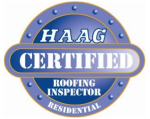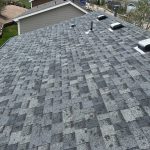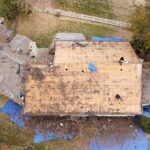
Step by Step: Hail Damaged Roof Action Plan
Hailstorms can be a destructive force of nature, leaving behind a trail of damage to properties, particularly roofs. If you find yourself dealing with a hail-damaged roof in Centennial or Parker, Colorado, it’s crucial to know what steps to take to ensure the safety of your home and initiate the repair process promptly. In this comprehensive guide, we will walk you through the necessary actions to address the situation effectively and get your roof back in top shape.
hail-damaged roof in Centennial or Parker, Colorado, it’s crucial to know what steps to take to ensure the safety of your home and initiate the repair process promptly. In this comprehensive guide, we will walk you through the necessary actions to address the situation effectively and get your roof back in top shape.
Step by Step: What to do if you have a hail-damaged roof in Centennial and Parker Colorado from a recent storm.
 Dealing with a hail-damaged roof can be overwhelming, but following these steps will help you navigate the situation with ease and efficiency:
Dealing with a hail-damaged roof can be overwhelming, but following these steps will help you navigate the situation with ease and efficiency:
-
- Assess the damage: Start by examining your roof for any visible signs of damage. Look for dents, cracks, missing shingles, or granule loss. If you feel uncomfortable or unsure about climbing onto your roof, it’s best to hire a professional roofing contractor to perform the inspection.
- Contact your insurance company: Once you’ve assessed the damage, reach out to your insurance company to file a claim. Provide them with accurate information about the extent of the damage and any supporting documentation or photos you have.
- Document the damage: Take clear photographs or videos of the hail damage to your roof. These visual records will serve as valuable evidence during the insurance claims process.
- Seek professional assistance: Engage the services of a reputable roofing contractor who specializes in hail damage repairs. Make sure they are licensed, insured, and experienced in working with insurance claims.
- Obtain multiple estimates: It’s wise to obtain multiple estimates from different roofing contractors to compare prices and services. This will help you make an informed decision when selecting a contractor to repair your hail-damaged roof.
- Check your insurance policy: Review your insurance policy to understand the coverage you have for hail damage. Pay attention to deductibles, coverage limits, and any specific requirements or exclusions.
- Schedule the repairs: Once you have chosen a roofing contractor, schedule the repair work at a convenient time. Coordinate with the contractor to ensure they have all the necessary materials and permits.
- Temporary fixes: In case of leaks or further damage, consider implementing temporary fixes like covering damaged areas with tarps or plastic sheets to prevent water intrusion until the repairs can be completed.
- Keep documentation: Throughout the entire process, keep detailed records of all communication, including phone calls, emails, and written correspondence. This documentation will help you track progress, provide evidence if needed, and facilitate smooth communication with your insurance company.
- Follow up with the insurance company: Stay in contact with your insurance company to stay updated on the progress of your claim. Ask about any additional documentation or information they may require.
- Coordinate with your contractor: Communicate regularly with your roofing contractor to stay informed about the repair timeline and any unexpected issues that may arise during the process.
- Inspect the repairs: Once the repairs are complete, carefully inspect the work to ensure it meets your expectations and addresses all the identified hail damage. Discuss any concerns or issues with your contractor promptly.
- Finalize the insurance claim: Once you are satisfied with the repairs, notify your insurance company. They will typically send an adjuster to inspect the completed work and finalize the claim.
14. Preventive measures: After experiencing hail damage, it’s essential to take preventive measures to minimize the risk of future damage.
Consider the following:
-
-
- Install impact-resistant roofing materials: Opt for impact-resistant shingles or metal roofing that can withstand hailstorms better than traditional materials.
- Trim overhanging trees: Trim tree branches that hang over your roof to prevent them from causing additional damage during a hailstorm.
- Regular roof inspections: Schedule regular roof inspections by professionals to identify and address any vulnerabilities or maintenance issues.
- Maintain gutters and downspouts: Ensure your gutters and downspouts are clear of debris to prevent water backup, which can lead to leaks and further damage during heavy rain or hailstorms.
- Consider hail-resistant covers: Explore the possibility of installing hail-resistant covers for vulnerable areas, such as skylights or vent pipes.
-
15. Frequently Asked Questions (FAQs):
Can I assess hail damage on my roof without climbing up?
While it’s best to have a professional inspect your roof, you can often identify some signs of hail damage from the ground. Look for visible dents, cracks, or missing shingles. However, for a thorough assessment, it’s recommended to hire a roofing professional.
How long do I have to file an insurance claim for hail damage?
Insurance companies usually have specific timelines for filing claims after an incident. Check your insurance policy or contact your insurance provider to determine the deadline for filing a hail damage claim.
Will my insurance cover the full cost of repairs?
The coverage for hail damage repairs varies depending on your insurance policy. Review your policy to understand the deductibles, coverage limits, and any exclusions that may apply.
Should I get multiple estimates for repairs?
Obtaining multiple estimates from different roofing contractors allows you to compare prices, services, and credibility. It’s advisable to gather multiple estimates to make an informed decision.
What if I discover additional damage during the repair process?
If your roofing contractor identifies additional damage during the repair process, inform your insurance company immediately. They may send an adjuster to reassess the damage and adjust the claim accordingly.
Can I perform temporary repairs on my own?
If you’re comfortable with DIY repairs, you can implement temporary fixes such as covering damaged areas with tarps or plastic sheets. However, it’s crucial to remember that these are temporary solutions, and professional repairs are necessary for a long-term fix.
Final Thoughts
Experiencing hail damage to your roof can be stressful, but by following the appropriate steps, you can address the situation effectively. Start by assessing the damage and contacting your insurance company to initiate the claims process. Seek professional assistance from a reputable roofing contractor like New Roof Plus, and maintain clear communication throughout the repairs.
Taking preventive measures can also help minimize the risk of future damage. Remember to document all communication and stay organized throughout the process. By being proactive and thorough, you can restore your hail-damaged roof and protect your home from further harm.


